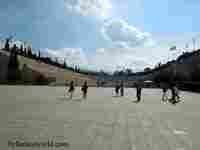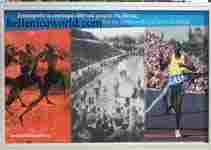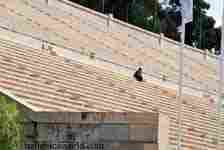.
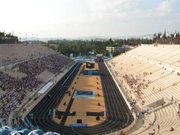
The Panathinaiko (Panathenaic) Stadium
Panathinaiko Stadium (also known as the Kallimarmaron, i.e. the "beautifully marbled") in Athens is the only major stadium in the world built fully of white marble (from Mount Penteli). It should not be confused with the Panathinaikos football field (officially called the Apostolos Nikolaidis stadium) at Alexandras Avenue.
In ancient times it was used to host the athletic portion of the Panathenaic Games in honour of the Goddess Athena. During classical times the stadium had wooden seating. It was remade in marble by the archon Lycurgus in 329 BC and was enlarged and renovated by Herod Atticus in 140 BC, to a capacity of 50,000. The remnants of the ancient structure were excavated in 1870.

1896 Olympic Games , Athens, 6th event in the 5th day. The winner of the Marathon race Spyridon Louis is entering the stadium joined by the Royal Princes of Greece
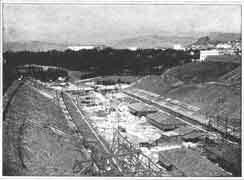
Construction of the Panathenaic Stadium for the Olympic Games 1896
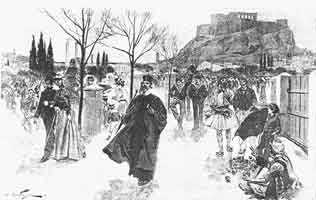
On the way to the Panathenaic Stadium for the Olympic Games 1896
It was fully rebuilt in 1895 in order to host the first modern Olympic Games, with funding provided by the magnate George Averoff (whose marble statue now stands at the entrance) and on designs by architects Anastasios Metaxas and Ernst Ziller. The stadium was built long before dimensions for athletics venues were standardized and its track and layout follow the ancient hairpin-like model. It can seat about 80,000 spectators.
It is located in downtown Athens, east of the National Gardens and the Zappeion Mansion, west of the Pankrati residential district and between the twin pine-covered hills of Ardettos and Agra. In ancient times the Ilissos River (now covered by, and flowing underneath, Vasileos Konstantinou Avenue) ran in front of the stadium's entrance, and the spring of Kallirrhoe, the sanctuary of Pankrates (a local hero) and the Cynosarges public gymnasium were nearby.
The Fokianos sports facility lies across Vasileos Konstantinou Avenue, and next to it are located the Athens tennis club, the Ethnikos athletics track, the Federation swimming pool, the remnants of the Temple of Olympian Zeus, and Hadrian's Gate. Until the late 19th century and the containment of the Ilissos riverbed, the area was reedy and often flooded, and was called the "Vatrahonisi" (Frog Island).

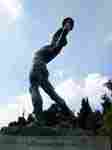
Discus Thrower , Discus Thrower ,
Sculpture of Kostas Dimitriadis ( Κώστας Δημητριάδης) (1881 Stenimaho East Romylia /Thrace - 28.10.1943 Athens) at the entrance of the stadium.
In more recent years this stadium has been often used to honour the homecoming of victorious Greek athletes, most notably the Greek national football team after its victory at the 2004 European Football Championship and also the opening ceremony of the World Athletics Championships in 1997, on a concept by composer Vangelis Papathanasiou.
In the 2004 Olympic Games, the Panathinaiko Stadium hosted the archery competition, and served as the finish site for the men's and women's Marathon races.
Links
Athens 2004 website
Olympic Stadia
Athens, 1896 | Paris, 1900 | St Louis, 1904 | London, 1908 | Stockholm, 1912 | Berlin, 1916 | Antwerp, 1920 | Paris, 1924 | Amsterdam, 1928 | Los Angeles, 1932 | Berlin, 1936 | Helsinki, 1940 | London, 1944 | London, 1948 | Helsinki, 1952 | Melbourne, 1956 | Rome, 1960 | Tokyo, 1964 | Mexico City, 1968 | Munich, 1972 | Montreal, 1976 | Moscow, 1980 | Los Angeles, 1984 | Seoul, 1988 | Barcelona, 1992 | Atlanta, 1996 | Sydney, 2000 | Athens, 2004 | Beijing, 2008 | London, 2012
| Ancient Greece
Science, Technology , Medicine , Warfare, , Biographies , Life , Cities/Places/Maps , Arts , Literature , Philosophy ,Olympics, Mythology , History , Images Medieval Greece / Byzantine Empire Science, Technology, Arts, , Warfare , Literature, Biographies, Icons, History Modern Greece Cities, Islands, Regions, Fauna/Flora ,Biographies , History , Warfare, Science/Technology, Literature, Music , Arts , Film/Actors , Sport , Fashion --- |
Retrieved from "http://en.wikipedia.org/"
All text is available under the terms of the GNU Free Documentation License
